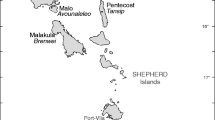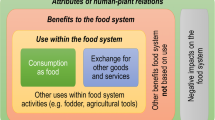Abstract
Kubo producer-units (families and independent bachelors) could have been self-sufficient in the production of bananas but chose not to be. Nor did they seek self-sufficiency in the production of any combination of staple carbohydrate foods (bananas, tubers, sago flour) or, in the long term, strive for balance in the exchange of food with other producer-units. Despite the fact that bananas, which provided 50% of people's energy needs, were a delayed-return crop Kubo communities were very unstable. This instability and the failure to choose the option of self-sufficiency were connected and were mediated through intense intracommunity sharing that, ultimately, served to negotiate a concern with sorcery. The people grew bananas in the way they did, not out of environmental necessity, but to accommodate the crop to the needs of sharing and, thereby, facilitate community living.
Similar content being viewed by others
References
Arsdale, P. W. van (1978). Activity patterns of Asmat hunter-gathers: A time budget analysis.Mankind 11: 453–460.
Balée, W. (1985). Ka'apor ritual hunting.Human Ecology 13: 485–510.
Barlett, P. F. (1980). Cost-benefit analysis: A test of alternative methodologies. In Barlett, P. F. (ed.),Agricultural Decision Making: Anthropological Contributions to Rural Development. Academic Press, New York, pp. 137–160.
Beek, A. van (1987).The Way of All Flesh: Hunting and Ideology of the Bedamuni of the Great Papuan Plateau (Papua New Guinea). Unpublished doctoral dissertation in anthropology, University of Leiden.
Bose, S. (1964). Economy of the Onge of Little Andaman.Man in India 44: 289–310.
Brosius, J. P. (1991). Foraging in tropical rain forests: The case of the Penan of Sarawak, East Malaysia (Borneo).Human Ecology 19: 123–150.
Chagnon, N. A. (1968).Yanomamö: The Fierce People. Holt, Rinehart and Winston, New York.
de Garine, I., and Harrison, G. (eds.) (1988).Coping with Uncertainly in Food Supply. Clarendon Press, Oxford.
Douglas, M. (1970).Purity and Danger: An Analysis of Concepts of Pollution and Taboo. Penquin Books, Middlesex.
Dwyer, P. D. (1990).The Pigs that Ate the Garden: A Human Ecology from Papua New Guinea. University of Michigan Press, Ann Arbor.
Dwyer, P. D., and Minnegal, M. (1988/89). Supplication of the crocodile: A curing ritual from Papua New Guinea.Australian Natural History 22: 490–494.
Dwyer, P. D., and Minnegal, M. (1991a). Hunting and harvesting: The pursuit of animals by Kubo of Papua New Guinea. In Pawley, A. (ed.),Man and a Half: Essays in Pacific Anthropology and Ethnobiology in Honour of Ralph Bulmer. The Polynesian Society: Auckland.
Dwyer, P. D., and Minnegal, M. (1991b). Hunting in lowland tropical rainforest: Towards a model of non-agricultural subsistence.Human Ecology. 19: 187–212.
Dwyer, P. D., and Minnegal, M. (in press a). Are Kubo hunters “show offs?”Ethology and Sociobiology.
Dwyer, P. D., and Minnegal, M. (in press b). Banana production by Kubo people of the interior lowlands of Papua New Guinea.Papua New Guinea Journal of Agriculture, Forestry and Fisheries.
Ellen, R. F. (1975). Non-domesticated resources in Nuaulu ecological relations.Social Science Information 14: 51–61.
Ellen, R. F. (1978).Nuaulu Settlement and Ecology: An Approach to the Environmental Relations of an Eastern Indonesian Community. Martinus Nijhoff, The Hague.
Ellen, R. F. (1979). Sago subsistence and the trade in spices. A provisional model of ecological succession and imbalance in Moluccan history. In Burnham, P., and Ellen, R. (eds.),Social and Ecological Systems. Academic Press, London, pp. 43–74.
Ellen, R. F. (1982).Environment, Subsistence and System: The Ecology of Small-Scale Social Formations. Cambridge University Press, Cambridge.
Ellen, R. F. (1991 [1988]). Foraging, starch extraction and the sedentary lifestyle in the lowland rainforest of central Seram. In Ingold, T., Riches, D., and Woodburn, J. (eds.),Hunters and Gatherers 1: History, Evolution and Social Change. Berg, Oxford, pp. 117–134.
Feil, D. (1987).The Evolution of Highland Papua New Guinea Societies. Cambridge University Press, Cambridge.
Finkler, K. (1980). Agrarian reform and economic development: When is a landlord a client and a sharecropper his patron? In Barlett, P. F. (ed.),Agricultural Decision Making: Anthropological Contributions to Rural Development. Academic Press, New York, pp. 265–288.
Gibson, T. (1991 [1988]). Meat sharing as a political ritual: Forms of transaction versus modes of subsistence. In Ingold, T., Riches, D., and Woodburn, J. (eds.),Hunters and Gatherers 2: Property, Power and Ideology. Berg, Oxford, pp. 165–179.
Gross, D. R. (1983). Village movement in relation to resources in Amazonia. In Hames, R. and Vickers, W. (eds.),Adaptive Responses of Native Amazonians. Academic Press, New York, pp. 429–449.
Groube, L. (1989). The taming of the rain forests: A model for late pleistocene forest exploitation in New Guinea. In Harris, D., and Hillman, G. (eds.),Foraging and Farming: The Evolution of Plant Exploitation. Unwin Hyman, London, pp. 292–304.
Hames, R., and Vickers, W. (eds.) (1983).Adaptive Responses of Native Amazonians. Academic Press, New York.
Hames, R. B., and Vickers, W. T. (1982). Optimal diet breadth theory as a model to explain variability in Amazonian hunting.American Ethnologist 9: 358–378.
Harris, M. (1977).Cannibals and Kings: The Origins of Cultures. Random House, New York.
Harris, D. R. (1989). An evolutionary continuum of people-plant interaction. In Harris, D., and Hillman, G. (eds.),Foraging and Farming: The Evolution of Plant Exploitation. Unwin Hyman, London, pp. 11–26.
Hawkes, K. (1977). Co-operation in Binumarien: Evidence for Sahlin's model.Man (n.s.) 12: 459–483.
Hawkes, K. (1983). Kin selection and culture.American Ethnologist 10: 345–363.
Hawkes, K. (1991). Showing off: Tests of an hypothesis about men's foraging goals.Ethology and Sociobiology 12: 29–54.
Hawkes, K., Hill, K., and O'Connell, J. F. (1982). Why hunters gather: Optimal foraging and the Ache of Eastern Paraguay.American Ethnologist 9: 379–398.
Heffley, S. (1981). The relationship between northern Athapaskan settlement patterns and resource distribution: An application of Horn's model. In Winterhalder, B., and Smith, E. A. (eds.),Hunter-Gatherer Foraging Strategies: Ethnographic and Archeological Analyses. University of Chicago Press, Chicago, pp. 126–147.
Hurtado, A. M., Hawkes, K., Hill, K., and Kaplan, H. (1985). Female subsistence strategies among the Ache hunter-gatherers of Eastern Paraguay.Human Ecology 13: 1–28.
Jackson, R. (1982).Ok Tedi: The Pot of Gold. University of Papua New Guinea, Port Moresby.
Jochim, M. A. (1981).Strategies for Survival: Cultural Behavior in an Ecological Context. Academic Press, New York.
Johnson, A. (1983). Machiguenga gardens. In Hames, R., and Vickers, W. (eds.),Adaptive Response of Native Amazonians. Academic Press, New York, pp. 29–63.
Kaplan, H., and Hill, K. (1985). Food sharing among Ache foragers: Test of explanatory hypotheses.Current Anthropology 26: 223–246.
Kelly, R. C. (1976). Witchcraft and sexual relations: An exploration in the social and semantic implications of the structure of belief. In Brown, P., and Buchbinder, G. (eds.),Man and Woman in the New Guinea Highlands. Special Publication No. 8, American Anthropological Association, pp. 36–53.
Kelly, R. C. (1977).Etoro Social Structure: A Study in Structural Contradiction. University of Michigan Press, Ann Arbor.
Knauft, B. M. (1985a). Ritual form and permutation in New Guinea: Implications of symbolic process for socio-political evolution.American Ethnologist 12: 321–340.
Knauft, B. M. (1985b).Good Company and Violence: Sorcery and Social Action in a Lowland New Guinea Society. University of California Press., Berkeley.
Knauft, B. M. (1987). Reconsidering violence in simple human societies: Homicide among the Gebusi of New Guinea.Current Anthropology 28: 457–500.
Langlas, C. M., and Weiner, J. F. (1988). Big-men, population growth, and longhouse fission among the Foi, 1965–79. In Weiner, J. W. (ed.),Mountain Papuans: Historical and Comparative Perspectives from New Guinea Fringe Highlands Societies. University of Michigan Press, Ann Arbor, pp. 73–110.
Lee, R. B. (1979).The !Kung San: Men, Women, and Work in a Foraging Society. Cambridge University Press, Cambridge.
Meehan, B. (1982).Shell Bed to Shell Midden. Australian Institute of Aboriginal Studies, Canberra.
Milton, K. (1984). Protein and carbohydrate resources of the Maku Indians of northwest Amazonia.American Anthropologist 86: 7–27
Milton, K. (1991). Comparative aspects of diet in Amazonian forest-dwellers.Philosophical Transactions of the Royal Society of London, Series B 334: 253–263.
Moran, E. F. (1991). Human adaptive strategies in Amazonian blackwater ecosystems.American Anthropologist 93: 361–382.
Morren, G. E. (1977). From hunting to herding: Pigs and the control of energy in montane New Guinea. In Bayliss-Smith, T., and Feachem, R. (eds.),Subsistence and Survival: Rural Ecology in the Pacific. Academic Press, London, pp. 273–315.
Morren, G. E. (1986)).The Miyanmin: Human Ecology of a Papua New Guinea Society. Iowa State University Press, Ames.
O'Connell, J., and Hawkes, K. (1984). Food choice and foraging sites among the Alyawara.Journal of Anthropological Research 40: 504–535.
Ohtsuka, R. (1983).Oriomo Papuans: Ecology of Sago Eaters in Lowland Papua. University of Tokyo Press, Tokyo.
Pedersen, J., and Wsehle, E. (1991 [1988]). The complexities of residential organization among the Efe (Mbuti) and the Bagombi (Baka): A critical view of the notion of flux in hunter-gatherer societies. In Ingold, T., Riches, D., and Woodburn, J. (eds.),Hunters and Gathers 1: History, Evolution and Social Change. Berg, Oxford, pp. 75–90.
Peterson, J. T. (1978). Hunter-gatherer/farmer exchange.American Anthropologist 80: 335–351.
Quiatt, D., and Kelso, J. (1985). Household economics and hominid origins.Current Anthropology 26: 207–222.
Sahlins, M. (1974).Stone Age Economics. Tavistock Publications, London.
Sandbukt, VO. (1991 [1988]). Tributary tradition and relations of affinity and gender among the Sumatran Kubu. In Ingold, T., Riches, D., and Woodburn, J. (eds.),Hunters and Gatherers 1: History, Evolution and Social Change. Berg, Oxford, pp. 107–116.
Schieffelin, E. L. (1976).The Sorrow of the Lonely and the Burning of the Dancers. St. Martins Press, New York.
Serpenti, L. (1977).Cultivators in the Swamps: Social Structure and Horticulture in a New Guinea Society. Van Gorcum and Co., Assen.
Shaw, R. D. (1975).Samo Social Structure: A Socio-Linguistic Approach to Understanding Interpersonal Relationships. Unpublished doctoral dissertation in anthropology, University of Papua New Guinea.
Shaw, R. D. (1986). The Bosavi language family.Pacific Linguistics Series A 70: 45–76.
Shaw, R. D. (1990).Kandila: Samo Ceremonialism and Interpersonal Relationships. University of Michigan Press, Ann Arbor.
Silberbauer, G. B. (1981).Hunter and Habitat in the Central Kalahari Desert. Cambridge University Press, Cambridge.
Smith, E. A. (1985). Inuit foraging groups: Some simple models incorporating conflicts of interest, relatedness, and central-place sharing.Ethology and Sociobiology 6: 27–47.
Smith, E. A. (1991 [1988]). Risk and uncertainty in the “original affluent society”: Evolutionary ecology of resource-sharing and land tenure. In Ingold, T., Riches, D., and Woodburn, J. (eds.),Hunters and Gatherers 1: History, Evolution and Social Change. Berg, Oxford, pp. 222–251.
Sorenson, E. R. (1976).The Edge of the Forest: Land, Childhood and Change in a New Guinea Protoagricultural Society. Smithsonian Institution Press, Washington.
Sørum, A. (1980). In search of the lost soul: Bedamini spirit seances and curing rites.Oceania 50: 273–296.
Speth, J. D. (1990). Seasonality, resource stress, and food sharing in so-called “egalitarian” societies.Journal of Anthropological Archaeology 9: 148–188.
Sponsel, L. E. (1986). Amazon ecology and adaptation.Annual Review of Anthropology 15: 67–97.
Turnbull, C. M. (1968). The importance of flux in two hunting societies. In Lee, R. B., and DeVore, I. (eds.),Man the Hunter. Aldine Publishing Company, New York, pp. 132–137.
Turnbull, C. M. (1972). Demography of small-scale societies. In Harrison, G., and Boyce, A. (eds.),The Structure of Human Populations. Clarendon Press, Oxford, pp. 283–312.
Wagner, R. (1967).The Curse of Souw. University of Chicago Press, Chicago.
Weiner, J. F. (1988a).The Heart of the Pearlshell: The Mythological Dimension of Foi Sociality. University of California Press, Berkeley.
Weiner, J. F. (1988b). Introduction: Looking at the New Guinea Highlands from its edge. In Weiner, J. F. (ed.),Mountain Papuans: Historical and Comparative Perspectives from New Guinea Fringe Highlands Societies. University of Michigan Press, Ann Arbor, pp. 1–38.
Werner, D. (1983). Why do the Mekranoti trek? In Hames, R., and Vickers, W. (eds.),Adaptive Responses of Native Amazonians. Academic Press, New York, pp. 225–238.
Woodburn, J. (1968). Stability and flexibility in Hadza residential groupings. In Lee, R. B., and DeVore, I. (eds.),Man the Hunter. Aldine Publishing Company, New York, pp. 103–110.
Woodburn, J. (1982). Egalitarian societies.Man (n.s.) 17: 431–451.
Woodburn, J. (1991 [1988]). African hunter-gatherer social organization: Is it best understood as a product of encapsulation? In Ingold, T., Riches, D., and Woodburn, J. (eds.),Hunters and Gatherers 1: History, Evolution and Social Change. Berg, Oxford, pp. 31–64.
Author information
Authors and Affiliations
Rights and permissions
About this article
Cite this article
Dwyer, P.D., Minnegal, M. Ecology and community dynamics of Kubo people in the tropical lowlands of Papua New Guinea. Hum Ecol 20, 21–55 (1992). https://doi.org/10.1007/BF00889695
Issue Date:
DOI: https://doi.org/10.1007/BF00889695




